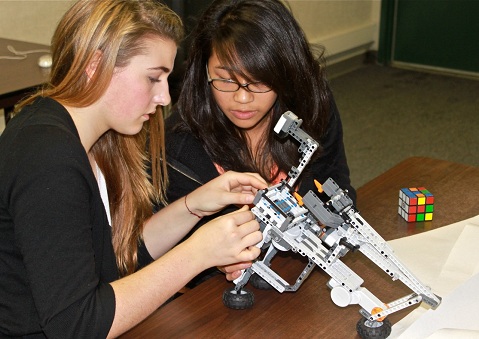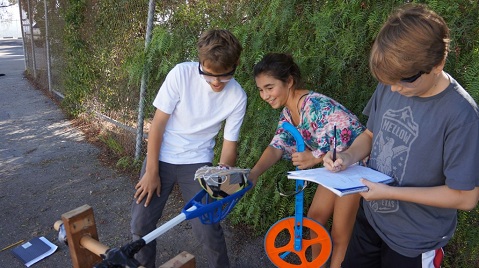Santa Barbara Middle School Dissects Science
Critical thinking, project-based learning, and hands-on labs are the everyday norm in SBMS science classrooms. Concepts such as false associations, confirmation bias and the placebo effect ring out daily in their class discussions and labs. This sounds more like a high school honors class or an engineering academy than your typical junior high school science classroom.

Russ Lewin is SBMS’ ninth grade Honors Geometry and Physics teacher. Lewin believes the two concepts are integral to one another. Lewin conducts a six-week intensive class in the winter, teaching students how to build and program small robots. Lewin shares, “Robotics allow students to exercise their mathematical skills through programming, and their design skills through engineering.” With a big smile he adds, “When everything comes together, it’s not uncommon for students to shriek, ‘It works!’” Students program the robots’ multiple sensors and motors to perform different actions simultaneously.
“I think there is an increase in confidence,” says Lewin, “all of a sudden the kids say, ‘I can program a robot to solve a Rubik’s Cube, and I’ve never done that before!’” After several weeks of training, each student team is given a challenge project that requires each team to apply their new-found abilities to solve a problem with a working robot that they have designed and built. All of these intricately designed projects lead the entire class toward increased confidence, understanding, and a fascination for the concepts of physics.
Dovetailing textbook learning into biological transplants is one of the ways eighth grade science teacher, Victor Dominocielo, gets his students to become hands-on scientists in his Human Biology class. “Hands-on science is the glue that connects all of the concepts,” says Dominocielo. First, Dominocielo’s students use microscopes and an arthroscopic machine with an attached camera to examine the different types of human body cells. “After we’ve studied the human body we move onto more complex organ systems, and ultimately into more specialized dissections. Students apply their newly acquired knowledge in our final lab where they dissect two mammals, transplant their hearts and reattach the major vessels with sutures,” says Dominocielo. According to Dominocielo, he thinks that this is a memorable lab where the students really step up in maturity, and in their scientific approach to authentic learning.
While project-based learning connects many kids with science, others gravitate to traditional book learning. Dominocielo also teaches scientific literacy in everyday life by observing, and then examining the critical thinking mistakes people are prone to make. “Students become more scientifically adept in the way they examine a topic when they understand the Post Hoc Fallacy or Confirmation Bias, two theories that support the idea that we are more likely to favor information that supports our own beliefs,” says Dominocielo. He believes both project-based and traditional textbook learning lead kids toward greater depth and understanding in the area of science.
Sixth and seventh grade science teacher Jesse Kasehagen, says many of his students come in with varying degrees of background knowledge in science. The nature of science, being methodical and precise, can create some reluctance and fear in new scientists. With this in mind, Kasehagen lets his students choose a topic within the sixth and seventh grade state curriculum that interests them. He says this open exploration and research helps break down that perceived wall that science always has to be right. “Science can be fun. It’s all about asking questions. When students begin to explore they realize they can figure things out for themselves. They are capable, and they realize that science is just a process. The final answer isn’t always available,” Kasehagen professes.
As part of Kasehagen’s physics curriculum, students learn to design and construct catapults. The catapults become a “real” tool for teaching how energy is transferred. Students work together to design and build the complex machine with recyclable materials and power tools. They then test their catapult by launching an object at a set target. They are also asked to write a description of how their catapult is designed to work in terms of simple machines and energy transfer. But Kasehagen feels the big lesson in this month-long science construction is about teamwork, and using that to tackle real life challenges and then come up with a solution.

“Most of the time I see the students get that big ‘ah-ha’ when they learn a new concept while going through the process of inquiry and problem solving.” Kasehagen continues, “Students are witnessing a practical application to a problem and instantly become more interested in science.” The final outcome of these catapult launches gives the students a feeling of success, especially when they witness the object go farther than they had expected.
Taking textbook concepts and translating them into real-life application is what SBMS science teachers do best. They know that when their students are actively engaged in solving real world problems through experimentation, trial and error, collaboration, and when students are excited about the process, that their learning becomes real. More than anything, students learn that even in the precise world of science, there is always more than one way to solve a problem.

